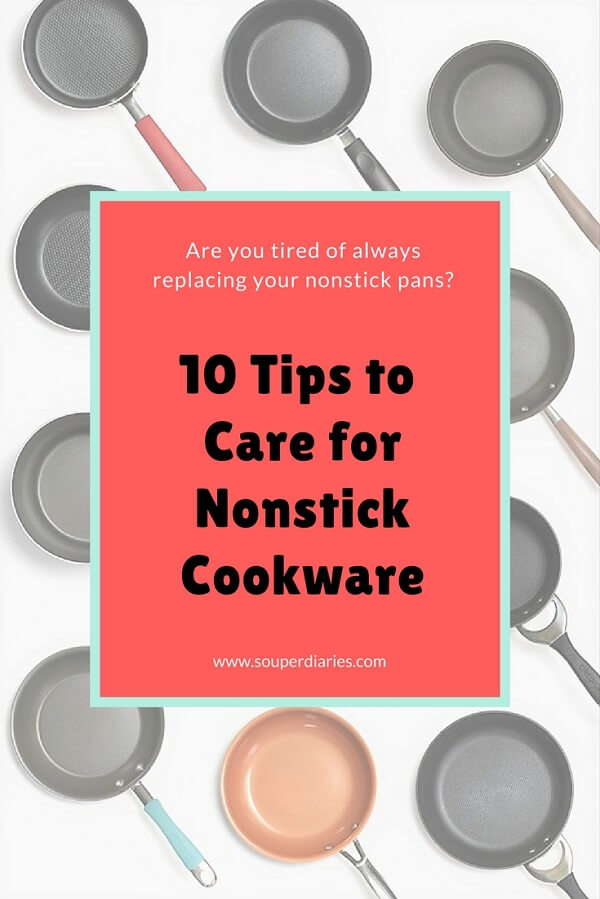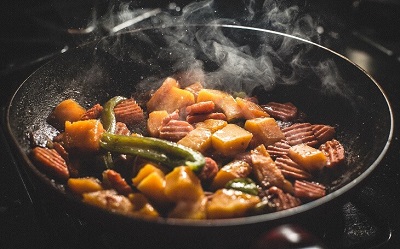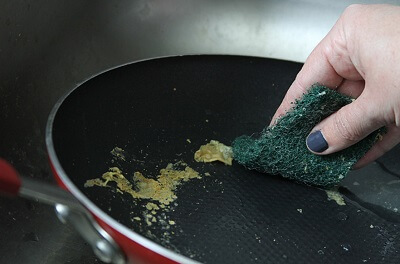Are you one of those who love to use nonstick cookware but is fed up of having them replaced ever so often? After ruining many of my nonstick pans, I resolved to take better care of them.
Nonstick pans are a great kitchen tool but they’re not as durable as other cookwares like cast iron and stainless steel. That’s why you’d want to follow these tips to care for your nonstick cookware to extend their lifespan for as long as possible.

Before we get into the nitty-gritty, these are signs that the nonstick coating of your pan is wearing off.
- The surface of your nonstick pan is getting dull and the shine is gone.
- Food starts to stick easily and more oil is needed to cook.
While it’s best to check with your cookware’s manufacturer for specific instructions and recommendations, here are some general tips on how to care for nonstick cookware.
1. Pre-season the pan before the first use
A little seasoning can help to prolong the cookware’s life. For new pans, clean the pan gently with a soft sponge to remove any manufacturing residue. The Kitchn recommends adding a thin layer of oil to the cookware. Then heat in a 300°F oven for an hour. Let cool and wipe off excess oil with paper towels.
I personally would check the cookware’s manual before putting any nonstick pans into the oven for the maximum temperature advised. Some pans cannot go into the oven at all. If that is the case, wash first before lightly greasing the pan’s surface with oil. Then heat over medium heat for a few minutes. Let cool, wash with mild detergent and rinse clean. Now it’s ready to be used.
2. Do not use cooking sprays on nonstick pans
Using cooking sprays time after time will cause residue to build up especially on the sides of the pan if it isn’t properly washed after each use. Eventually, this will cause the pan to turn sticky and food to cook unevenly.
3. Avoid preheating an empty pan
Some nonstick pans can potentially produce unhealthy fumes when it is heated without oil. Oiling the pan also improves the nonstick effects of the cookware.
4. Cook on low and medium heat
Avoid cooking with high heat. Over time, constant exposure to high heat will cause the nonstick coating to deteriorate. That being said, some nonstick pan’s coating have a higher tolerance to heat. I find that Happycall’s pan with titanium coating allows me to cook with higher heat.
How hot is too hot? According to Good HouseKeeping, at temperatures above 500ºF, the breakdown of teflon begins and smaller chemical fragments are released.
Nonstick pans can rise quickly to the maximum recommended temperature for cooking (500ºF), so use low to moderate heat and allow the pan to rise to the desired temperature slowly.

Avoid cooking over high heat
5. Use Safe Cooking Utensils
Don’t use metal utensils of any kind (forks, knives, metal spatulas, whisks, etc) on your nonstick pans. Ever. They might pierce and damage the nonstick coating of the pan. Wooden spoons and silicone spatulas with rounded edges are a better choice. I use them on all my cookware and even on those made with stainless steel.
Lately I’ve been using only silicone spatulas when cooking on my nonstick cookware. Why silicon spatulas? They are more flexible compared to wooden spoons. Even if you accidentally pressed too hard on the pan, you will not leave scratches (including hairline ones) on your pan. They also do not get stained easily.
Some meats with sharp edges (think t-bone steaks, lamb chops, pork chops and the like) may also leave hairline scratches when moved about in the nonstick pan. So, when it comes to cooking these kinds of meat, I would prefer to use other cookware like stainless steel or cast iron.
6. Let nonstick cookware cool first before washing
Washing a very hot pan in cold water is not advisable. Sudden changes in temperature could permanently warp your pan and warped pans do not cook food evenly. This affects cheaper pans more than the higher end ones. Allow your pan to cool before washing. Wash all traces of food carefully and completely. Then rinse thoroughly and dry. A clean pan will ensure consistent and quality performance.
7. Hand-wash and dry after every use
Even if your nonstick pans claim to be dishwasher safe, it is much better to hand-wash them to protect the surface. After using the pans, it’s best to hand wash and dry them soon with a soft cloth to prevent rust from forming. I personally do that for all my pots and pans regardless of the cookware material.
Remember to clean the bottom of the pan too when washing. Otherwise, food or oil residue will harden and stick. Over time, it will take some serious elbow grease to have it removed.
Be sure to use mild washing detergents and not abrasive cleaners and chemicals. It can be tempting to use a dishwasher for convenience but the intense heat and strong washing detergents can ruin the nonstick coating over time.
8. Don’t use abrasive cleaning materials
Steel wool, stiff bristle brushes or scouring pads are a big no-no. These will scratch the nonstick coating and cause permanent damage. If you find that your nonstick pan surface pitted or the coating is wearing off, it’s best to replace them. You don’t want bits of the coating to end up in your food.
When cleaning, always use soft sponges or wash cloths. If you have food stuck to your pan, let it soak in water for awhile to help loosen the hardened bits before cleaning.

Don’t use steel wool to scrub non-stick pans
9. Don’t store food in your nonstick pan
Certain foods (especially highly acidic food) can corrode the nonstick coating of your pan. To store leftover food, keep them in containers that are safe to be refrigerated. Your nonstick pans are meant for cooking and not for food storage. Also, storing them in your nonstick cookware will promote a breeding ground for bacteria.
10. Store your nonstick cookware properly
Store them on their own as far as possible. If it is necessary to stack your nonstick cookware due to space constraint, put a soft cloth or dish towel between them to prevent the pots and pans from rubbing against each other and causing scratches.
And that’s it!
Nonstick pans are great to have in the kitchen. With careful use and good care, you can extend their lifespan a whole lot longer.
Remembering all the dos and don’ts may be hard so I’ve summarized them into an infographics. Here they are in a nutshell:

P/S: Feel free to pin it. Thanks!
Oh my! I have not been treating my non stick pans very nicely! Thank you for this post! I learned so many new things that I will start doing immediately for my non stick pans! Who knew that using cooking sprays and pre-heating were such a bad idea!
Thanks for dropping by, Bailey! I didn’t treat my previous nonstick pans very well either! It’s no wonder I had to change them constantly. Even though nonstick pans aren’t as hardy as other cookware materials like stainless steel or cast iron, a little care will go a long way to prolong their lifespan.
These are some great tips! I am definitely guilty of committing a few no-nos when it comes to caring for my non-stick pans. It’s probably time to buy some new ones and follow these guidelines!
Hi Yvonne, this is great.
My mum just gave me a new non-stick wok for my birthday and I was wondering what to do with it and how to take care of it.
I have a couple of older, regular steel woks and a couple of cast iron pans, which I love, and have never really gotten into the non-stick thing, but have been getting curious about it recently, thus my new wok.
I did not know about the pre-seasoning so this is a great starter, and I did not know about not using cooking oil sprays either, and the other tip about not heating up an empty pan are of course something I need to avoid as my cast iron pans require heating up, which is one reason I was looking at adding a non-stick pan or wok to my collection.
Thanks
Neil
Hi Neil,
Happy belated birthday! I hope you’ll enjoy using your new gift if you haven’t already. I have a regular steel wok too and I love it. It’s been with me for more than a decade. As for my nonstick pans, I’ve lost count of how many I went through over the years. Non stick cookware won’t last indefinitely in my opinion. But with a little care, it can last for a much longer time. Thanks for writing in.
Hello Vonnie, this is a great article. You explained a lot about the non-stickpan. Since I am in the market for a non-stick pan I will definitely use your guidelines.
Great tips!
We have a non-stick pan as well but it lost it’s non-stickyness (don’t know if that’s even a word), probably because I committed some of the sins you described above such as preheating an empty pan for a prolonged time and using metallic utensils for cooking. I know I scratched it because I can see marks and I’m sure the coating just wore off faster because of that. Thanks for you tips! Now I know what to do and what not to do for my next pan!
Hi Andy,
If the scratch marks are hairline ones and they are surface scratches, most likely it can still be used. The danger part is when the scratch marks expose the material under the nonstick coating. Then I would suggest that the pan be discarded.
These tips on caring for non-stick cookware are very useful. Before reading your post, I was only aware of the more common reminders such as taking care to not scratch the pan, and refraining from using abrasive cleaning materials on the poor pan. I’ll try to keep the others in mind when cooking with non-stick cookware in the future! (Especially the one about not washing hot non-stick cookware in cold water…I’m guilty of that, oops!)
Hi Sienna,
I’m glad you find these tips on caring for nonstick cookware useful. I’ve also ‘abused’ my poor nonstick pan unknowingly sometimes. Lol. I’ve used high heat before when I was impatient and in a hurry. I too will have to take better care of my non-stick cookware! 🙂
Very useful household tips, expecially for guys!
Hi Stephane,
I’m glad you find them useful. Thanks for visiting! 🙂
Great tips on how to use and care for a non stick cookware.
I must admit I’m guilty of rinsing my pan off while it’s still hot, have to stop that bad habit…
Great tips, thank you!
Vicky
Hi Vicky,
I’m guilty of some of the things not to do when cooking with nonstick pans too. I did not pre-season my pan and I’ve cooked on high heat before (yikes!). But nowadays I find myself babying my nonstick pans and treating them with tender loving care 🙂
Hi Yvonne,
This is a great find as I am thinking about buying a nonstick pan, and had little information on how I would take care of it. I also appreciate how you added a personal touch so that we feel we are having a conversation with you. I like the fact that you have short paragraphs, but you have a lot of them–all necessary and well written. Still, I wonder if you need to have an image to break up the writing? Maybe something in the middle? Just something to consider. You can always take out the image if it doesn’t work.
In any case, I wish you the best of luck.
Thabo
Hi Thabo,
Thank you for your comments and feedback. I will keep them in mind. 🙂
Thanks for the tips here. I am definitely fed up of having to buy new pans every couple years because my old ones just don’t do it anymore. I never thought to preseason them but that definitely sounds like a good idea and will have to incorporate it into my routine.
You’re welcome, James. I too will pre-season all my new nonstick cookware from now on 🙂
Ciao ,
That’s a very nice article which I can use in my field of profession because we work in Food and beverage. I liked the tips about how to maintain your equipment. I will share this with most of my Chef friends.
I’m glad you found them useful and thanks for sharing!